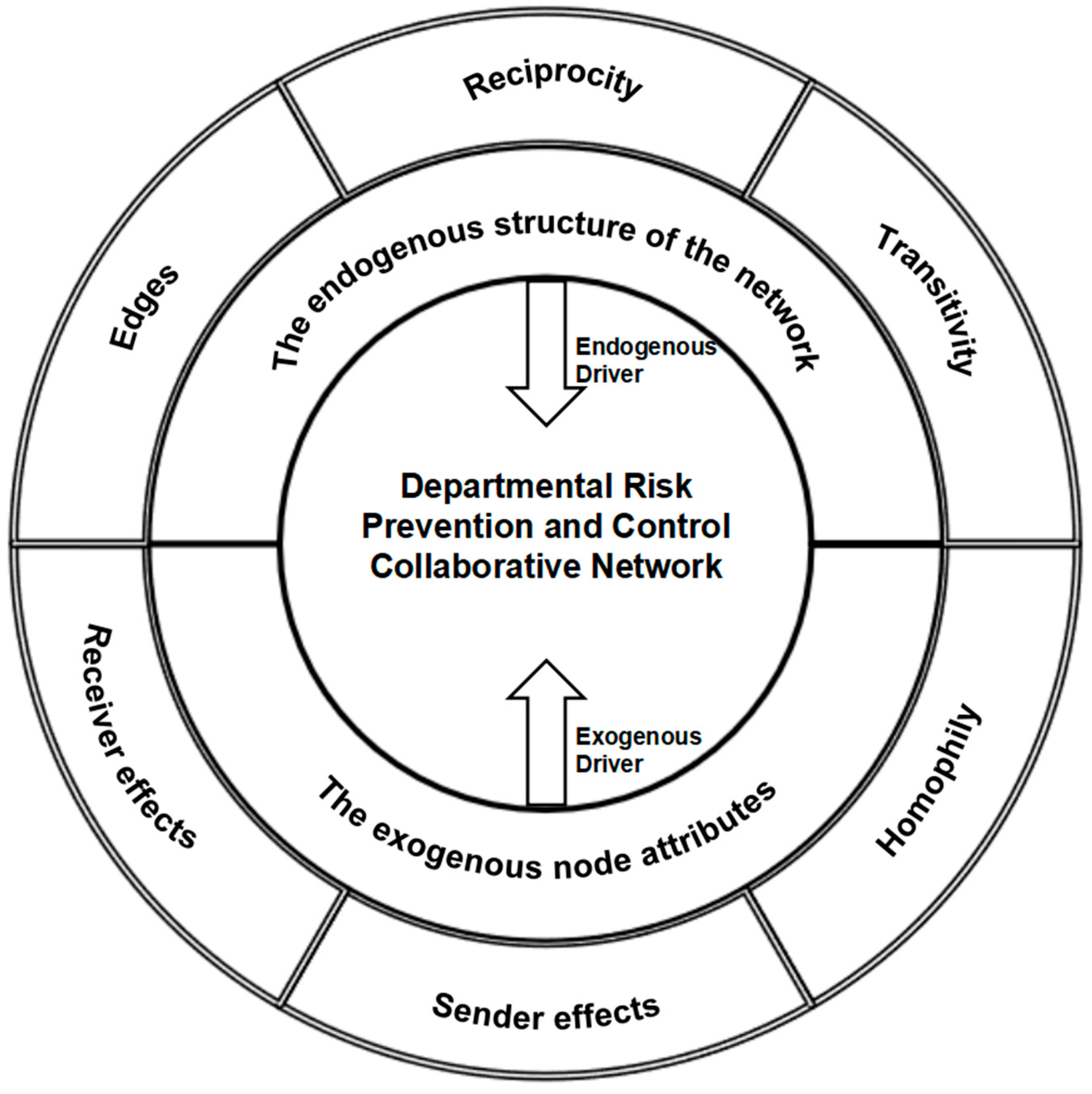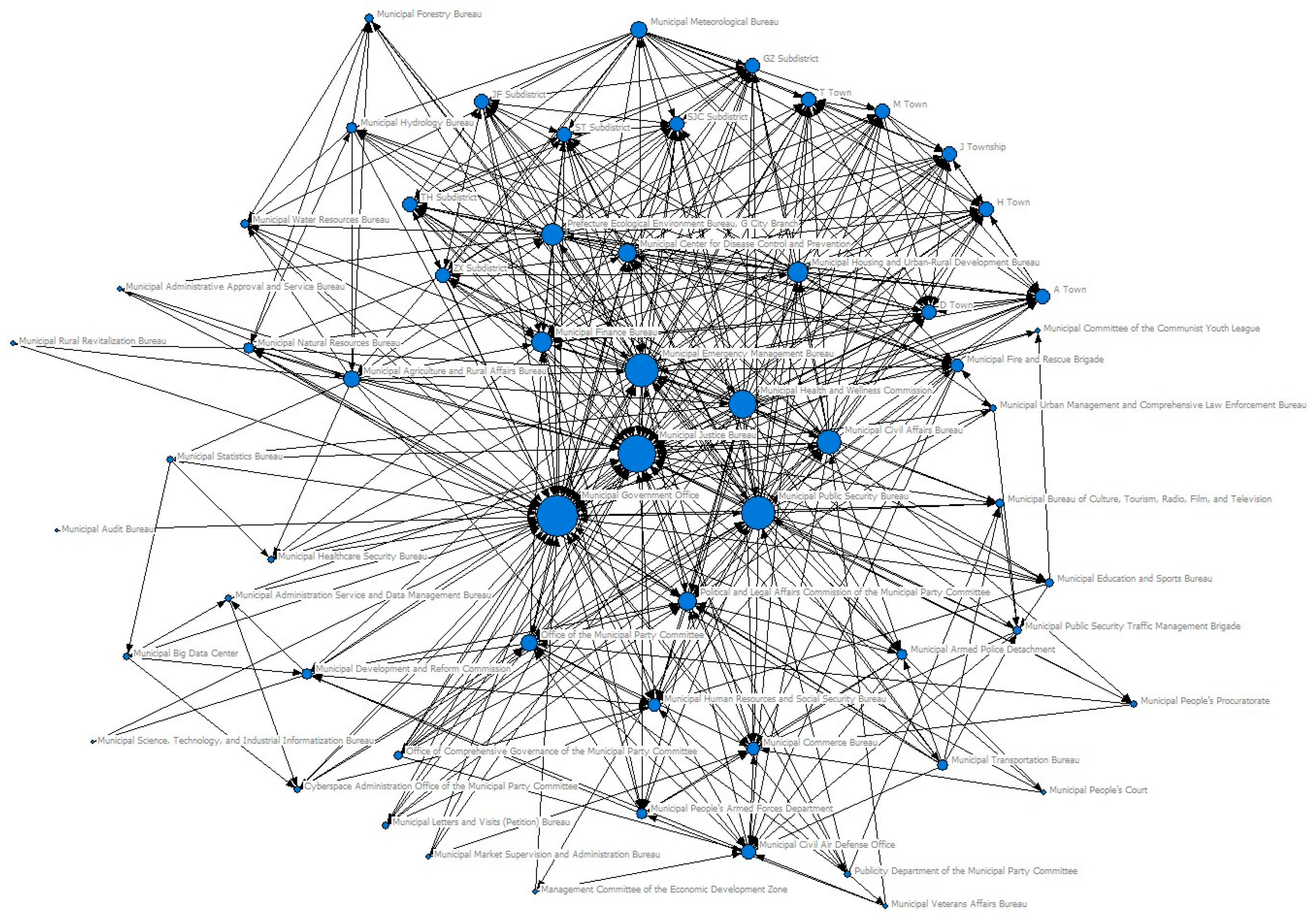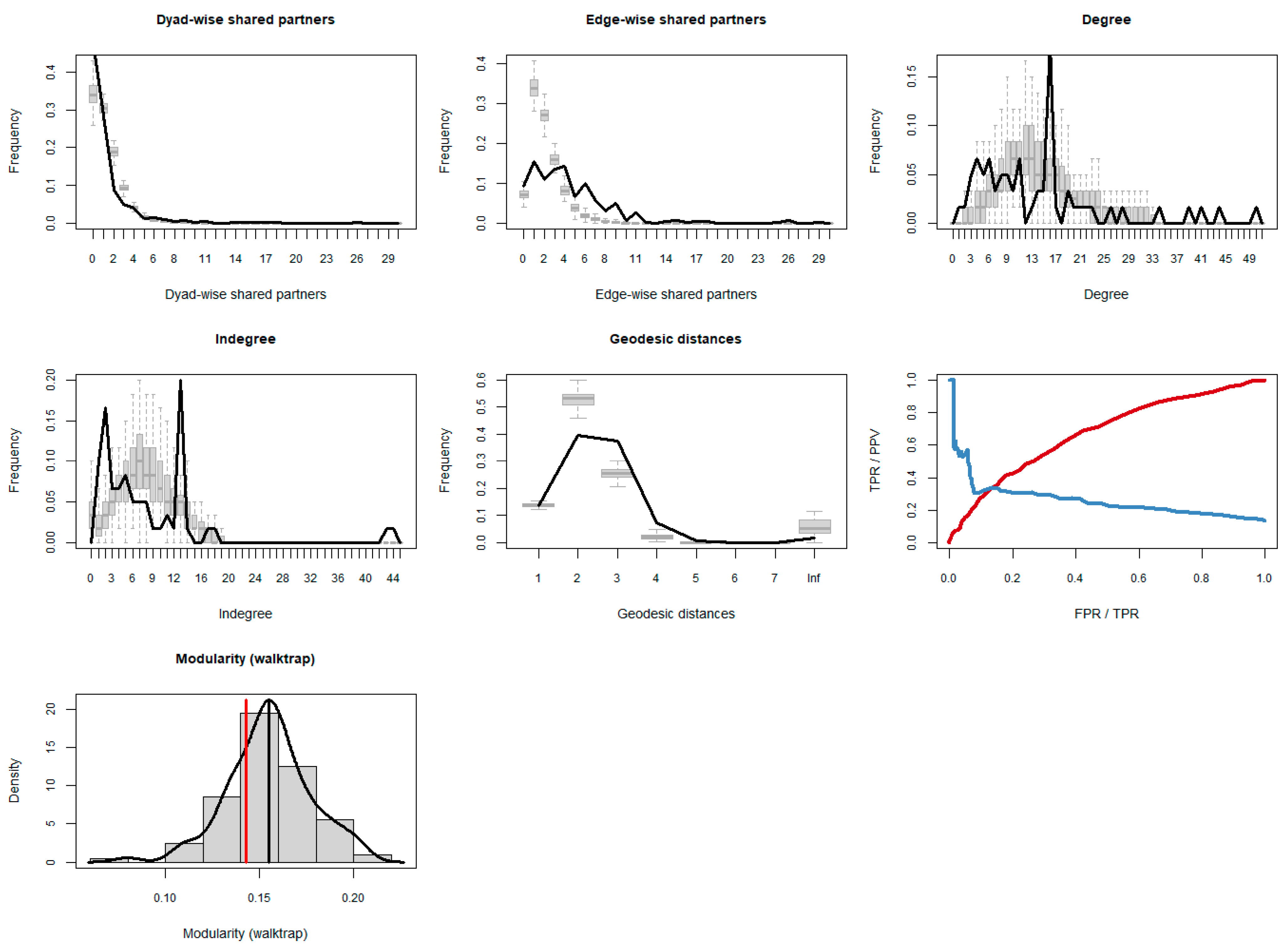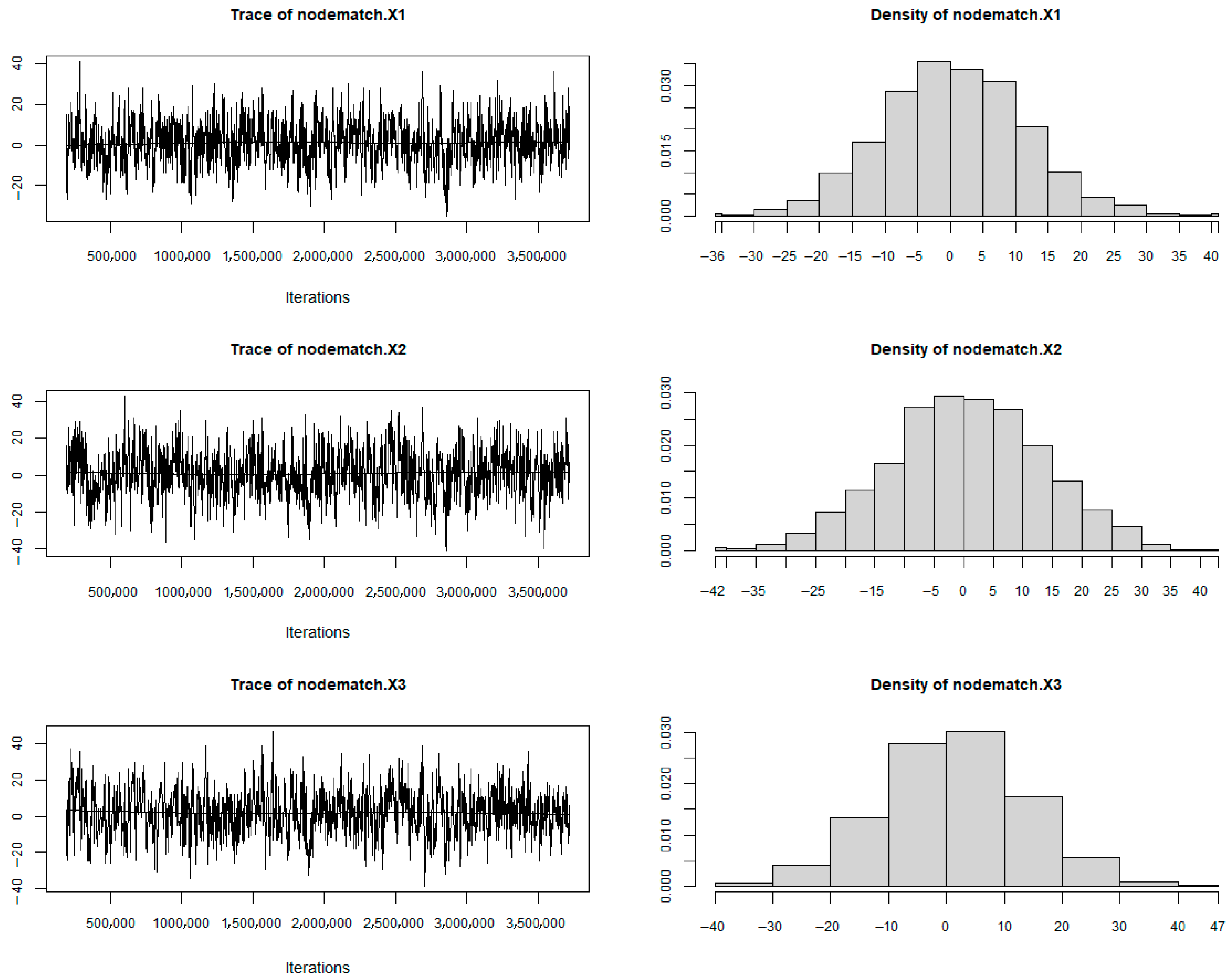The Structure and Driving Mechanisms of the Departmental Collaborative Network in Primary-Level Social Risk Prevention and Control: A Network Study of J City, China
Abstract
1. Introduction
2. Literature Review
3. Theoretical Mechanisms and Research Hypotheses
3.1. Effects of Endogenous Structures on the Collaborative Network
3.1.1. Reciprocity Effect
3.1.2. Transitivity Effect
3.2. Effects of Exogenous Node Attributes on the Collaborative Network
3.2.1. Influence of Departments’ Information Communication Capacity
3.2.2. Influence of Departments’ Digital Technology Utilization Capacity
3.2.3. Influence of Departments’ Resource Mobilization Capacity
4. Research Methods and Data Sources
4.1. Data Sources and Processing
4.2. Research Methods
4.2.1. Social Network Analysis
4.2.2. Exponential Random Graph Model
| Type | Variable | Network Configuration | Description |
|---|---|---|---|
| Endogenous Structural Variables | Edges | — | Baseline effect analogous to an intercept, representing overall tie propensity. |
| Mutual Reciprocity | — | Captures reciprocity in the network, indicating the tendency for departments to engage in mutual collaboration. | |
| GWESP | — | Measures network closure, representing the tendency for departments sharing multiple partners to form ties. | |
| Node Attribute Variables | Information Communication Homophily (nodematch. X1) | Homophily | Departments with similar information communication capacities are more likely to establish collaborative ties. |
| Digital Technology Utilization Homophily (nodematch. X2) | Homophily | Departments with similar digital technology utilization capacities are more likely to establish collaborative ties. | |
| Resource Mobilization Homophily (nodematch. X3) | Homophily | Departments with similar resource mobilization capacities are more likely to establish collaborative ties. | |
| Initiator Information Capacity (nodeocov. X1) | Sender Effect | Departments with higher information communication capacities are more inclined to initiate collaboration. | |
| Initiator Digital Capacity (nodeocov. X2) | Sender Effect | Departments with higher digital technology utilization capacities are more inclined to initiate collaboration. | |
| Initiator Resource Capacity (nodeocov. X3) | Sender Effect | Departments with higher resource mobilization capacities are more inclined to initiate collaboration. | |
| Receiver Information Capacity (nodeicov. X1) | Receiver Effect | Departments with higher information communication capacities are more inclined to accept collaboration. | |
| Receiver Digital Capacity (nodeicov. X2) | Receiver Effect | Departments with higher digital technology utilization capacities are more inclined to accept collaboration. | |
| Receiver Resource Capacity (nodeicov. X3) | Receiver Effect | Departments with higher resource mobilization capacities are more inclined to accept collaboration. |
5. Results
5.1. Structural Characteristics of the Risk Prevention Departmental Collaborative Network
5.1.1. Analysis of Overall Structural Characteristics of the Risk Prevention Departmental Collaborative Network
5.1.2. Analysis of Cohesive Substructures Within the Risk Prevention Departmental Collaborative Network
5.1.3. Analysis of Individual Positional Roles in the Departmental Collaborative Network for Social Risk Prevention and Control
5.2. Driving Factors of the Risk Prevention Departmental Collaborative Network
5.2.1. Effects of Endogenous Network Structures
5.2.2. Effects of Exogenous Node Attributes
5.3. Goodness-of-Fit and MCMC Convergence Diagnostics
6. Conclusions and Discussion
Author Contributions
Funding
Institutional Review Board Statement
Informed Consent Statement
Data Availability Statement
Conflicts of Interest
References
- Holzmann, R.; Jørgensen, S. Social Risk Management: A New Conceptual Framework for Social Protection, and Beyond. Int. Tax Public Finance 2001, 8, 529–556. [Google Scholar] [CrossRef]
- Ye, F. 5 Urban Risk Prevention-and-Control System and Capacity Building. In Urban Risk Management in China: Principles, Methods and Practices; Elsevier: Amsterdam, The Netherlands, 2024; p. 185. [Google Scholar]
- Renn, O.; Lucas, K. Systemic Risk: The Threat to Societal Diversity and Coherence. Risk Anal. 2022, 42, 1921–1934. [Google Scholar] [CrossRef] [PubMed]
- Achillopoulou, D.V.; Mitoulis, S.A.; Argyroudis, S.A.; Wang, Y. Monitoring of Transport Infrastructure Exposed to Multiple Hazards: A Roadmap for Building Resilience. Sci. Total Environ. 2020, 746, 141001. [Google Scholar] [CrossRef] [PubMed]
- Scott, I.; Gong, T. Coordinating Government Silos: Challenges and Opportunities. Glob. Public Policy Gov. 2021, 1, 20–38. [Google Scholar] [CrossRef]
- Aven, T.; Renn, O. Improving Government Policy on Risk: Eight Key Principles. Reliab. Eng. Syst. Saf. 2018, 176, 230–241. [Google Scholar] [CrossRef]
- Joffe, H. Risk: From Perception to Social Representation. Br. J. Soc. Psychol. 2003, 42, 55–73. [Google Scholar] [CrossRef]
- Rosenthal, U.; Kouzmin, A. Crises and Crisis Management: Toward Comprehensive Government Decision Making. J. Public Adm. Res. Theory 1997, 7, 277–304. [Google Scholar] [CrossRef]
- Somers, S.; Svara, J.H. Assessing and Managing Environmental Risk: Connecting Local Government Management with Emergency Management. Public Adm. Rev. 2009, 69, 181–193. [Google Scholar] [CrossRef]
- Henderson, L.J. Emergency and Disaster: Pervasive Risk and Public Bureaucracy in Developing Nations. Public Organ. Rev. 2004, 4, 103–119. [Google Scholar] [CrossRef]
- Vantaggiato, F.P.; Kassim, H.; Connolly, S. Breaking out of Silos: Explaining Cross-Departmental Interactions in Two European Bureaucracies. J. Eur. Public Policy 2021, 28, 1432–1452. [Google Scholar] [CrossRef]
- Jarvis, D.S. Risk, Globalisation and the State: A Critical Appraisal of Ulrich Beck and the World Risk Society Thesis. Glob. Soc. 2007, 21, 23–46. [Google Scholar] [CrossRef]
- Vij, S. Polycentric Disaster Governance in a Federalising Nepal: Interplay between People, Bureaucracy and Political Leadership. Policy Sci. 2023, 56, 755–776. [Google Scholar] [CrossRef]
- Klinke, A.; Renn, O. Adaptive and Integrative Governance on Risk and Uncertainty. J. Risk Res. 2012, 15, 273–292. [Google Scholar] [CrossRef]
- Rocheleau, B. Interorganizational and Interdepartmental Information Systems: Sharing among Governments. Public Adm. Public Policy N. Y. 2005, 111, 59. [Google Scholar]
- Zhang, H.; Tao, Z. Evolution of Interdepartmental Collaboration Networks in Public Health Emergency Management. J. Wuhan Univ. Philos. Soc. Sci. Ed. 2021, 74, 114–126. (In Chinese) [Google Scholar]
- Yan, H.; Guo, P.; Zeng, D. How Is a “Third Way” of Cross-Departmental Collaborative Governance Possible? A Social Network Analysis of 300 Water Governance Cases. Acad. Res. 2021, 10, 67–74. (In Chinese) [Google Scholar]
- Huang, C.; Chen, W.; Yi, H. Collaborative Networks and Environmental Governance Performance: A Social Influence Model. Public Manag. Rev. 2021, 23, 1878–1899. [Google Scholar] [CrossRef]
- Yan, J.; Guo, Y.; Zhang, H. The Dynamic Evolution Mechanism of Structural Dependence Characteristics in the Global Oil Trade Network. Energy 2024, 303, 131914. [Google Scholar] [CrossRef]
- Lee, Y.; Lee, I.W.; Feiock, R.C. Interorganizational Collaboration Networks in Economic Development Policy: An Exponential Random Graph Model Analysis. Policy Stud. J. 2012, 40, 547–573. [Google Scholar] [CrossRef]
- Whetsell, T.A.; Kroll, A.; DeHart-Davis, L. Formal Hierarchies and Informal Networks: How Organizational Structure Shapes Information Search in Local Government. J. Public Adm. Res. Theory 2021, 31, 653–669. [Google Scholar] [CrossRef]
- Xu, H.; Feng, L.; Wu, G.; Zhang, Q. Evolution of Structural Properties and Its Determinants of Global Waste Paper Trade Network Based on Temporal Exponential Random Graph Models. Renew. Sustain. Energy Rev. 2021, 149, 111402. [Google Scholar] [CrossRef]
- Lu, C.; Li, B. The Influence Factors of Innovation Networking Formation Based on ERGM: Evidence from the Smart Medical Industry. J. Digit. Econ. 2023, 2, 64–80. [Google Scholar] [CrossRef]
- Mele, A. A Structural Model of Dense Network Formation. Econometrica 2017, 85, 825–850. [Google Scholar] [CrossRef]
- Ghafouri, S.; Khasteh, S.H. A Survey on Exponential Random Graph Models: An Application Perspective. PeerJ Comput. Sci. 2020, 6, e269. [Google Scholar] [CrossRef] [PubMed]
- Hunter, D.R.; Handcock, M.S.; Butts, C.T.; Goodreau, S.M.; Morris, M. Ergm: A Package to Fit, Simulate and Diagnose Exponential-Family Models for Networks. J. Stat. Softw. 2008, 24, 1–29. [Google Scholar] [CrossRef] [PubMed]
- Kim, J.Y.; Howard, M.; Cox Pahnke, E.; Boeker, W. Understanding Network Formation in Strategy Research: Exponential Random Graph Models. Strateg. Manag. J. 2016, 37, 22–44. [Google Scholar]
- van Der Pol, J. Introduction to Network Modeling Using Exponential Random Graph Models (Ergm): Theory and an Application Using R-Project. Comput. Econ. 2019, 54, 845–875. [Google Scholar] [CrossRef]
- Leifeld, P.; Schneider, V. Information Exchange in Policy Networks. Am. J. Polit. Sci. 2012, 56, 731–744. [Google Scholar] [CrossRef]
- Ostrom, E. Institutional Rational Choice: An Assessment of the Institutional Analysis and Development Framework. In Theories of the Policy Process, 2nd ed.; Routledge: Oxfordshire, UK, 2019; pp. 21–64. [Google Scholar]
- Siciliano, M.D.; Wukich, C. Network Features and Processes as Determinants of Organizational Interaction during Extreme Events. Complex. Gov. Netw. 2015, 2, 23–44. [Google Scholar] [CrossRef]
- Zhang, C.; Bu, Y.; Ding, Y.; Xu, J. Understanding Scientific Collaboration: Homophily, Transitivity, and Preferential Attachment. J. Assoc. Inf. Sci. Technol. 2018, 69, 72–86. [Google Scholar] [CrossRef]
- Murshed, S.T.H.; Uddin, S.; Hossain, L. Transitivity, Hierarchy and Reciprocity of Organizational Communication Network during Crisis. Int. J. Organ. Anal. 2015, 23, 2–20. [Google Scholar] [CrossRef]
- Siciliano, M.D. Advice Networks in Public Organizations: The Role of Structure, Internal Competition, and Individual Attributes. Public Adm. Rev. 2015, 75, 548–559. [Google Scholar] [CrossRef]
- Wang, R.; Shin, J. Determinants of Alliance Formation and Dissolution among International Health Organizations: The Influence of Homophily and Institutional Power in Affinity Communication Networks. Manag. Commun. Q. 2023, 37, 913–940. [Google Scholar] [CrossRef]
- Tabak, R.G.; Duggan, K.; Smith, C.; Aisaka, K.; Moreland-Russell, S.; Brownson, R.C. Assessing Capacity for Sustainability of Effective Programs and Policies in Local Health Departments. J. Public Health Manag. Pract. 2016, 22, 129–137. [Google Scholar] [CrossRef]
- Comfort, L.K. Shared Risk: Complex Systems in Seismic Response; Emerald Publishing: Leeds, UK, 1999. [Google Scholar]
- López, T. Building Local Health Department COVID-19 Emergency and Risk Communications Capacity. J. Public Health Manag. Pract. 2020, 26, 384–386. [Google Scholar] [CrossRef]
- Mitcham, D.; Taylor, M.; Harris, C. Utilizing Social Media for Information Dispersal during Local Disasters: The Communication Hub Framework for Local Emergency Management. Int. J. Environ. Res. Public Health 2021, 18, 10784. [Google Scholar] [CrossRef]
- Yihan, X.; Zhenlin, L. Digital Transformation and the Frontier of China’s State Governance. Soc. Sci. China 2024, 45, 70–91. [Google Scholar] [CrossRef]
- Pardo, T.A.; Gil-Garcia, J.R.; Luna-Reyes, L.F. Collaborative Governance and Cross-Boundary Information Sharing: Envisioning a Networked and IT-Enabled Public Administration. In The Future of Public Administration around the World: The Minnowbrook Perspective; Georgetown University Press: Washington, DC, USA, 2010; pp. 129–139. [Google Scholar]
- Roy, J. Digital Government and Service Delivery: An Examination of Performance and Prospects. Can. Public Adm. 2017, 60, 538–561. [Google Scholar] [CrossRef]
- Klein, L.L.; Pereira, B.A.D. The Survival of Interorganizational Networks: A Proposal Based on Resource Dependence Theory. RAM Rev. Adm. Mackenzie 2016, 17, 153–175. [Google Scholar] [CrossRef]
- AbouAssi, K.; Bowman, A.O.; Johnston, J.M.; Bauer, Z.; Tran, L. Relations, Resources, and Costs: Exploring Cross-Sectoral Collaboration at the Local Level in a Developing Country. Int. Public Manag. J. 2021, 24, 646–672. [Google Scholar] [CrossRef]
- Edwards, G. Mixed-Method Approaches to Social Network Analysis; NCRM: Southampton, UK, 2010. [Google Scholar]
- Thomson, A.M.; Perry, J.L. Collaboration Processes: Inside the Black Box. Public Adm. Rev. 2006, 66, 20–32. [Google Scholar] [CrossRef]
- Shrestha, M.; Berardo, R.; Feiock, R. Solving Institutional Collective Action Problems in Multiplex Networks. Complex. Gov. Netw. 2014, 1, 49–60. [Google Scholar] [CrossRef]
- Hawkins, C.V.; Hu, Q.; Feiock, R.C. Self-organizing Governance of Local Economic Development: Informal Policy Networks and Regional Institutions. J. Urban Aff. 2016, 38, 643–660. [Google Scholar] [CrossRef]
- Song, A.M.; Temby, O.; Kim, D.; Cisneros, A.S.; Hickey, G.M. Measuring, Mapping and Quantifying the Effects of Trust and Informal Communication on Transboundary Collaboration in the Great Lakes Fisheries Policy Network. Glob. Environ. Chang. 2019, 54, 6–18. [Google Scholar] [CrossRef]
- Freeman, L. The Development of Social Network Analysis. Study Sociol. Sci. 2004, 1, 159–167. [Google Scholar]
- Das, K.; Samanta, S.; Pal, M. Study on Centrality Measures in Social Networks: A Survey. Soc. Netw. Anal. Min. 2018, 8, 13. [Google Scholar] [CrossRef]
- Long, J.C.; Cunningham, F.C.; Braithwaite, J. Bridges, Brokers and Boundary Spanners in Collaborative Networks: A Systematic Review. BMC Health Serv. Res. 2013, 13, 158. [Google Scholar] [CrossRef]




| Network Metric | Value | Network Metric | Value |
|---|---|---|---|
| Density | 0.171 | Average Path Length | 2.191 |
| SD of Degree Distribution | 0.376 | Cohesion Index | 0.521 |
| Total Number of Ties | 604 | Network Width | 0.479 |
| Average Degree | 10.067 | Small-World Index | 1.963 |
| Variables | Model 1 | Model 2 | Model 3 |
|---|---|---|---|
| Edges | −1.836 *** (0.049) | −4.387 *** (0.202) | −5.662 *** (0.261) |
| Mutual | 0.474 *** (0.170) | 0.477 *** (0.182) | |
| GWESP | 1.825 *** (0.170) | 1.536 *** (0.167) | |
| Department Information Communication Capacity | 0.068 (0.120) | ||
| Department Digital Technology Utilization Capacity | 0.135 (0.115) | ||
| Department Resource Mobilization Capacity | 0.423 *** (0.115) | ||
| Initiating Department Information Communication Capacity | 0.079 ** (0.045) | ||
| Initiating Department Digital Technology Utilization Capacity | 0.261 *** (0.042) | ||
| Initiating Department Resource Mobilization Capacity | 0.085 ** (0.045) | ||
| Receiving Department Information Communication Capacity | 0.230 ** (0.046) | ||
| Receiving Department Digital Technology Utilization Capacity | −0.207 *** (0.046) | ||
| Receiving Department Resource Mobilization Capacity | −0.051 (0.046) | ||
| AIC | 2838 | 2611 | 2489 |
| BIC | 2844 | 2627 | 2563 |
Disclaimer/Publisher’s Note: The statements, opinions and data contained in all publications are solely those of the individual author(s) and contributor(s) and not of MDPI and/or the editor(s). MDPI and/or the editor(s) disclaim responsibility for any injury to people or property resulting from any ideas, methods, instructions or products referred to in the content. |
© 2025 by the authors. Licensee MDPI, Basel, Switzerland. This article is an open access article distributed under the terms and conditions of the Creative Commons Attribution (CC BY) license (https://creativecommons.org/licenses/by/4.0/).
Share and Cite
Zhang, L.; Zhang, H.; Jiang, Q. The Structure and Driving Mechanisms of the Departmental Collaborative Network in Primary-Level Social Risk Prevention and Control: A Network Study of J City, China. Systems 2025, 13, 617. https://doi.org/10.3390/systems13080617
Zhang L, Zhang H, Jiang Q. The Structure and Driving Mechanisms of the Departmental Collaborative Network in Primary-Level Social Risk Prevention and Control: A Network Study of J City, China. Systems. 2025; 13(8):617. https://doi.org/10.3390/systems13080617
Chicago/Turabian StyleZhang, Lirong, Haixing Zhang, and Qingzhi Jiang. 2025. "The Structure and Driving Mechanisms of the Departmental Collaborative Network in Primary-Level Social Risk Prevention and Control: A Network Study of J City, China" Systems 13, no. 8: 617. https://doi.org/10.3390/systems13080617
APA StyleZhang, L., Zhang, H., & Jiang, Q. (2025). The Structure and Driving Mechanisms of the Departmental Collaborative Network in Primary-Level Social Risk Prevention and Control: A Network Study of J City, China. Systems, 13(8), 617. https://doi.org/10.3390/systems13080617




